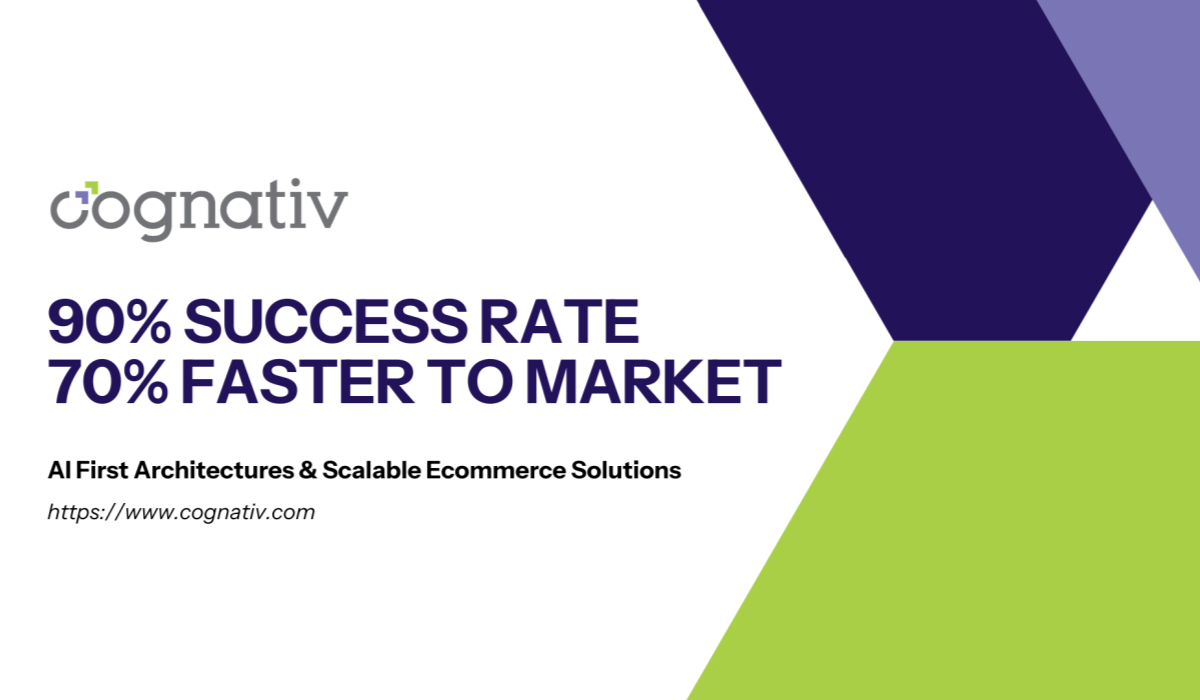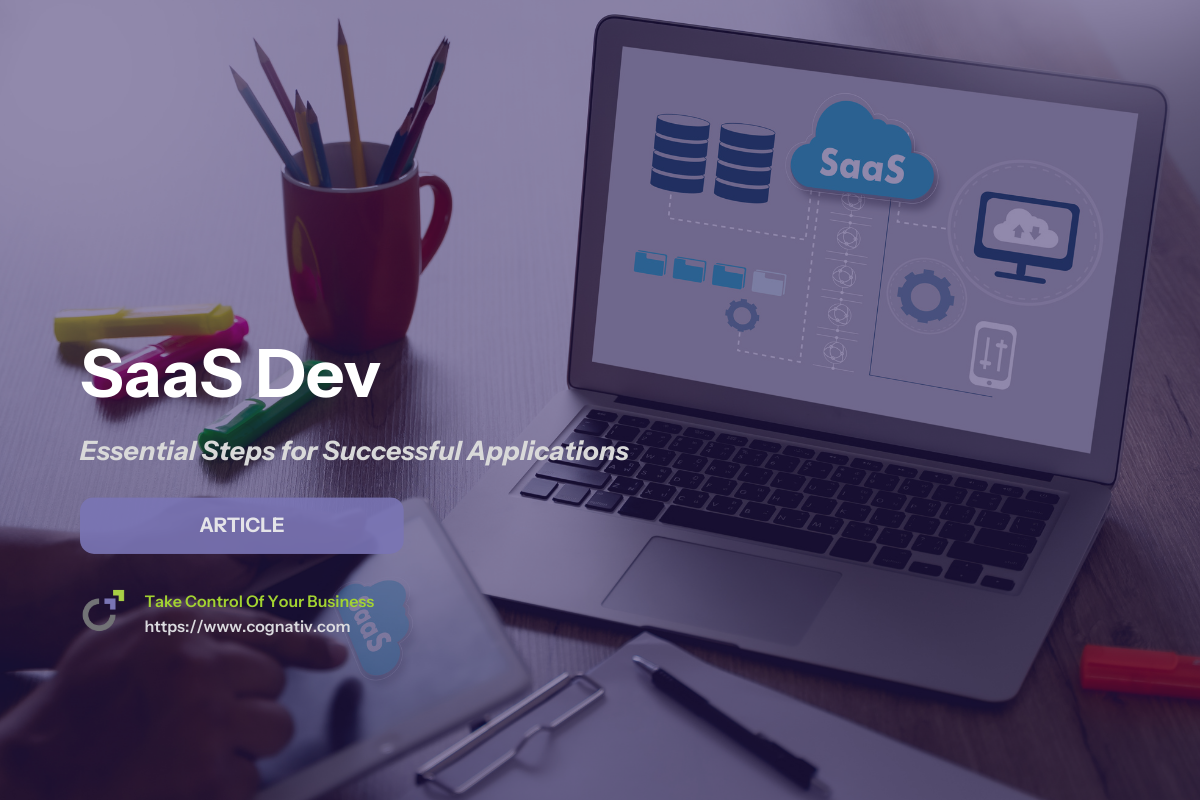

Thursday, June 12, 2025
Kevin Anderson
SaaS Dev: Essential Steps for Successful Applications
SaaS dev involves building Software as a Service applications that are hosted on central servers and accessed via web browsers. Unlike traditional software models, SaaS offers automatic updates, scalability, and cost-effectiveness. In this article, you’ll learn about the essential steps for successful SaaS development, including planning, architecture, and key considerations for security and integration.
Key Takeaways
-
SaaS applications offer significant advantages, including cost-effectiveness, automatic updates, and scalable architecture, allowing businesses to focus on core activities.
-
Key considerations for SaaS development include ensuring data security, effective system integration, and maintaining transparency with a Software Bill of Materials (SBOM).
-
The SaaS development process involves multiple stages such as market research, MVP creation, and iterative testing, which are crucial for aligning the product with user needs and ensuring successful scaling.
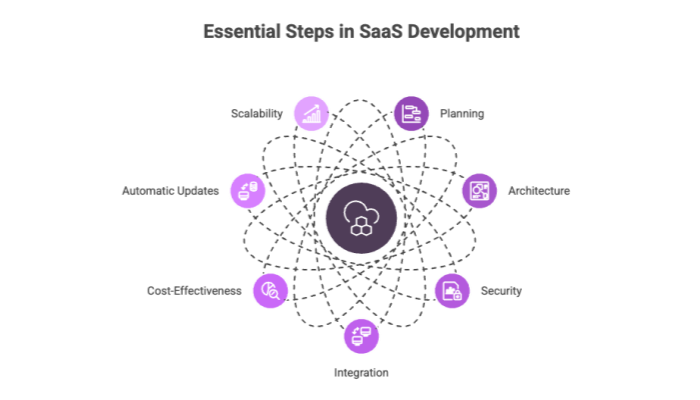

Understanding SaaS Development
SaaS, or Software as a Service, represents a paradigm shift in how saas software development is delivered and consumed. Unlike traditional software that demands installation on individual computers and manual updates, the saas model for SaaS applications:
-
Reside on central servers
-
Are accessed via web browsers
-
Offer automatic updates, ensuring all users always have the latest version without any effort on their part.
A standout feature of SaaS is its multi-tenant architecture, which:
-
Allows multiple customers to share the same application instance while keeping their data secure and private.
-
Optimizes resource usage.
-
Simplifies maintenance and scalability.
With SaaS, a saas business can focus more on their core activities, leaving the complexities of software management to the SaaS provider and adopting a saas business model.
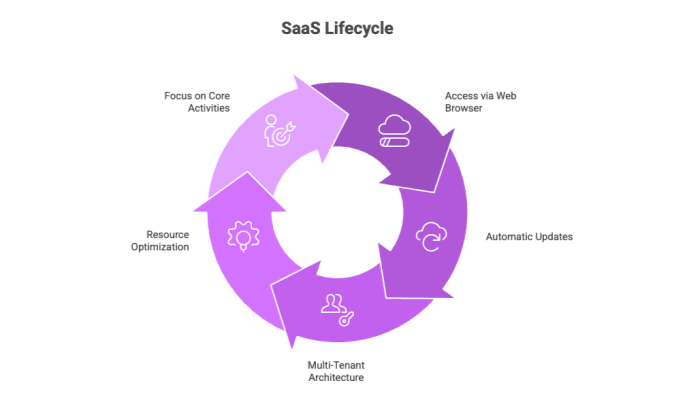

Benefits of SaaS Applications
One of the most compelling benefits of SaaS applications is their cost-effectiveness. The subscription model allows users to pay a recurring fee instead of a hefty one-time purchase cost, making it more accessible to a broader audience. Lower upfront costs also lead to a larger potential customer base, enhancing the scalability of the business. Furthermore, SaaS models offer significant cost savings and numerous benefits:
-
Recurring income
-
Low initial costs
-
Scalability
-
Global reach
These features make SaaS attractive for both users and saas providers in the saas market and among saas vendors.
The convenience of automatic updates cannot be overstated. SaaS platforms offer several key benefits:
-
Streamlined maintenance and updates managed centrally by vendors.
-
Users always have access to the latest features and security patches without any manual intervention.
-
Access to SaaS applications from any device with an internet connection, providing unparalleled flexibility.
Also, SaaS applications offer several key benefits:
-
Ensure global accessibility, allowing users to work remotely from anywhere in the world.
-
Provide flexibility with seamless switching between devices, enhancing the overall user experience.
-
Continually improve by offering automatic updates and new features, ensuring users benefit from the latest advancements without disruption. Additionally, saas apps enhance collaboration and productivity across teams.


Key Considerations for SaaS Development
In the realm of SaaS app development, data security is of paramount importance. Key security measures include:
-
Strong encryption to protect data stored off-site
-
Adherence to regulations such as GDPR and HIPAA
-
Implementing robust security measures like data encryption and access controls
These practices help safeguard customer data protection, ensuring privacy and compliance with standards.
Integration with other systems is another critical consideration. Key points include:
-
Well-documented APIs facilitate seamless data exchange, allowing the SaaS application to interact smoothly with third party services and platforms.
-
Early planning of integrations and choosing the right third-party tools are vital for successful integration, considering the technical aspects involved.
-
Selecting the right cloud service provider is crucial for the application’s overall performance, security, and cost-effectiveness.
Incorporating a Software Bill of Materials (SBOM) in SaaS development is beneficial for maintaining transparency in software dependencies and managing security vulnerabilities. This proactive approach helps in identifying and addressing potential security risks early in the development process, ensuring a robust and secure SaaS solution.
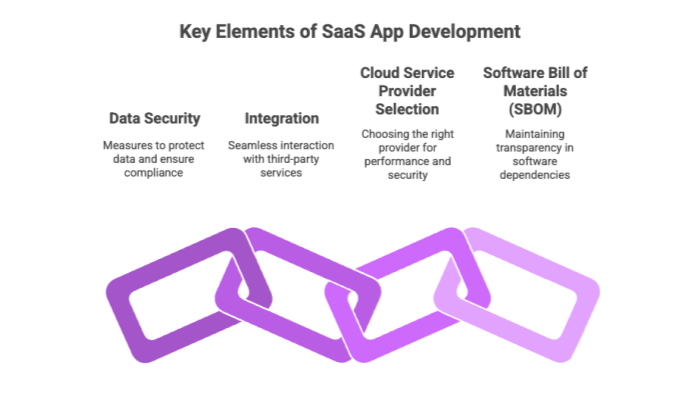

SaaS App Development Process
The SaaS app development process is intricate and involves multiple stages, starting with market research and idea validation. This initial phase ensures that the product aligns with user needs and market demand. Expert guidance is crucial throughout the software development process to navigate potential pitfalls and ensure a successful outcome in developing saas applications.
Post-launch, continuous user feedback and performance tracking are essential for refining the application and adding custom features based on user requests. Ongoing maintenance is a well-planned and carefully executed approach vital for a successful go-live, ensuring the application meets user expectations and performs reliably.
Market Research and Idea Validation
Market research is the cornerstone of a successful SaaS development project. Conducting a thorough market analysis helps ensure that the product will meet user needs and demands. Tools like the Value Proposition Canvas (VPC) are invaluable in uncovering users’ needs, pains, and desires, guiding the development of a solution that addresses these aspects effectively.
Validation methods such as user interviews and ‘smoke tests’ are crucial for testing hypotheses about the application. A smoke test, for instance, involves using a landing page to gauge initial interest by measuring conversion metrics, thereby validating the product concept before full development.
Identifying primary and secondary functionalities through market research ensures a focused and relevant target audience development process.
Defining Project Scope
Defining the project scope is a critical step in SaaS development. This involves establishing the core functionality and key features of the Minimum Viable Product (MVP). The primary goal is to deliver essential aspects for version 1.0, ensuring that the product meets user needs from the outset.
Creating a product roadmap provides a clear guide for building the product while ensuring alignment with the overall vision and user requirements. It is important to revisit and adjust the roadmap as more is learned about the product and market.
Wireframes or low-fidelity prototypes can assist in illustrating detailed user stories, enhancing the clarity of development requirements.
UI/UX Design
UI/UX design is a critical component of SaaS application development. The aim is to create intuitive, efficient, and accessible user experiences with ui components. Wireframes or low-fidelity prototypes are useful tools for reproducing detailed user stories and guiding the design process.
High-fidelity prototypes emphasize guiding users seamlessly through core functionalities, ensuring a smooth and satisfying user experience. Utilizing UX testing tools and conducting research with real users can help avoid costly changes in UI/UX design and ensure that the final product meets user expectations.


Choosing the Right Technology Stack
Selecting the right technology stack is crucial for accelerating MVP development and supporting future growth. The technology stack for SaaS development typically includes:
-
Frontend frameworks
-
Backend frameworks
-
Databases
-
Servers
-
Infrastructure configuration Choosing the appropriate technologies can significantly influence both performance and long-term expenses.
Recommended technologies for SaaS development include Node.js for the backend, React for the frontend, and cloud providers like AWS or Azure for infrastructure. Specialized development platforms and low-code platforms can significantly reduce development time, providing tailored tools for niche or industry-specific needs in SaaS application development platforms, SaaS based application development, SaaS platform development, and SaaS developers.
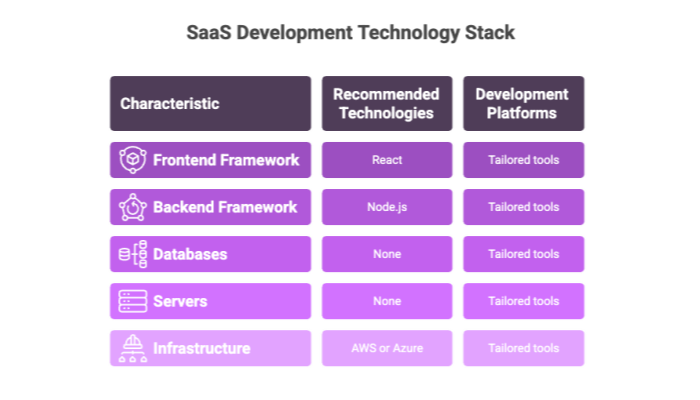

Monetization Models for SaaS
The monetization model is a crucial aspect of SaaS application development. Common models include:
-
Freemium
-
Subscription
-
Usage-based
-
Hybrid models
The subscription-based model is particularly popular, offering a stable and predictable revenue stream.
Understanding market dynamics and seasonality patterns helps SaaS businesses forecast subscription purchases and optimize pricing strategies. Reliable cash flow is vital for strengthening financial health and allowing for reinvestment in the business. Different monetization strategies can significantly influence customer acquisition and retention, making it essential to choose the right model for your SaaS application.
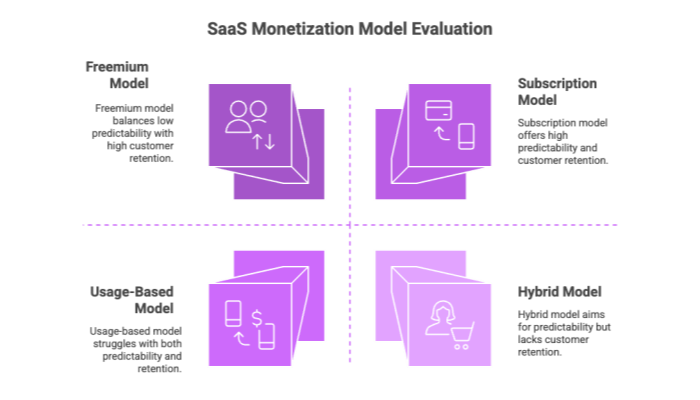

Developing Your SaaS Product
The process of developing a SaaS product starts with a discovery and design sprint. This phase is crucial for:
-
Vetting the idea
-
Creating a development plan
-
Ensuring that users are willing to pay for the service, which is a key indicator of the product’s potential success.
Tracking metrics like Customer Lifetime Value (CLV) and Customer Acquisition Cost (CAC) helps measure the success of the SaaS product and guide further development.
MVP Development
A Minimum Viable Product (MVP) is a basic version of the application that covers only essential functionalities. The main goal of MVP development is to validate core functionality and gather user feedback, ensuring that the product meets user needs before full-scale development.
Developing an MVP is crucial for startups as it allows for early validation of basic functionality and helps avoid overbuilding or adding unnecessary complexity. The typical development timeline for an MVP ranges from 2 to 6 months, with costs between $25,000 and $100,000.
Outsourced development teams can offer a more budget-friendly approach to creating an MVP.
Full-Featured Product Development
Transitioning from an MVP to a full-featured product involves critical decisions, such as choosing between fully custom web app development for ultimate flexibility or using enterprise SaaS frameworks that may come with higher licensing fees but speed up delivery. This phase typically requires careful planning, as developing complex, enterprise-grade SaaS applications can take 6 to 12 months or even longer.
Effective planning for both the development approach and the expected timeline is essential for a successful transition from an MVP to a complete product with advanced features. This includes addressing scalability, project management, project management software, integration capabilities, and ensuring the product meets the evolving needs of its users.
Testing and Iteration
Testing and iteration are fundamental to the SaaS development process. Load, stress, and compatibility testing ensure that SaaS applications perform well under varying conditions, preventing potential performance bottlenecks. Incorporating user feedback into the development process helps avoid costly changes and guides future improvements.
The SaaS product development process is inherently iterative, allowing for continuous enhancements based on user interactions. This iterative approach helps in refining the product, ensuring it meets user expectations and remains competitive in the market.
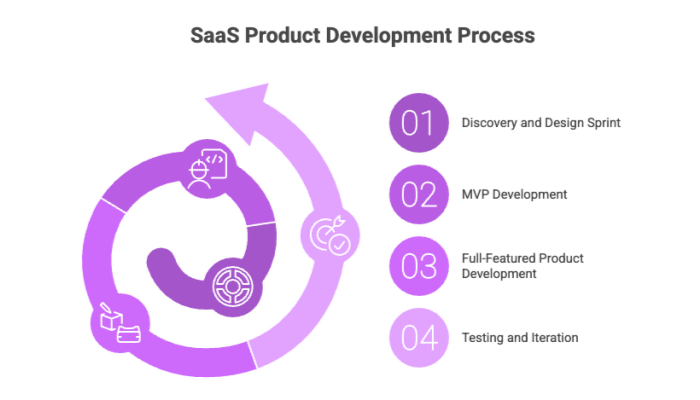

Scaling Your SaaS Application
Scalability is a crucial aspect of SaaS application development. A scalable SaaS product can accommodate a growing user base without affecting performance. SaaS applications must be able to elastically scale up and down based on user demand, ensuring that the application maintains performance and stability.
Microservices architecture allows for individual scaling of application components, enhancing agility and speed. Tools like Docker and Kubernetes facilitate containerization and automated management of applications, optimizing the management and scaling of microservices architectures.
Real-time monitoring tools help identify performance bottlenecks, enhancing the overall stability of SaaS applications.
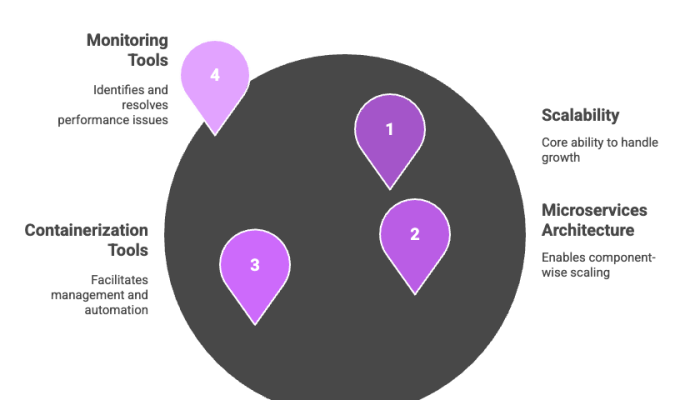

Challenges in SaaS Development
SaaS development presents several challenges, including ensuring data isolation in multi-tenancy architectures to prevent security breaches between different tenants. Cyber threats such as data breaches and ransomware pose significant risks to the security of SaaS applications, making it essential to implement end-to-end encryption and conduct regular security audits.
Performance bottlenecks are common issues in SaaS systems, particularly during sudden traffic spikes from users. Using load balancers can help distribute user traffic evenly across servers, preventing performance bottlenecks and ensuring a smooth user experience.
Successful SaaS models require addressing integration complexities and designing for scalability from the outset.


SaaS Development Costs
The cost of developing a SaaS application can vary widely:
-
Developing a basic MVP can range from $30,000 to $80,000.
-
A full-scale SaaS product typically costs between $150,000 and $500,000.
-
The saas application development cost for enterprise-grade solutions can potentially exceed $300,000 due to advanced features.
Ongoing costs can include:
-
Maintenance and feature updates, which can cost over $50,000 annually
-
Hosting costs, ranging from $500 to $10,000 per month depending on traffic
-
Compliance requirements like HIPAA or GDPR, which can add significant costs to the development process
To reduce development costs, starting with a lean Version 1.0 focusing on core features and gathering user feedback is a recommended strategy.


Selecting a SaaS Development Team
Choosing the right SaaS development team is critical for the success of your project. Options include:
-
In house team: provide greater alignment with business objectives, as developers gain deeper insights into the product and company processes.
-
Outsourced teams
-
Freelancers
-
SaaS development partner
Outsourcing offers faster access to skilled developers, allowing companies to avoid lengthy recruitment cycles and can enhance collaboration while maintaining cost savings through nearshoring. Hiring freelancers can be cost-effective for specific tasks but typically requires more oversight to ensure quality.
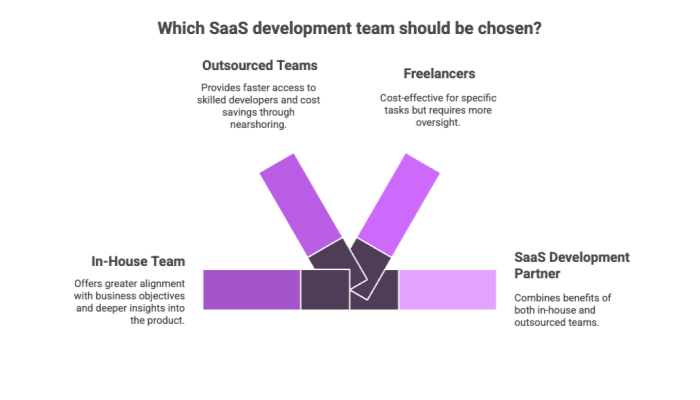

Successful SaaS Products: Case Studies
Real-life examples of successful SaaS products can provide valuable insights and inspiration. Kinderlime, developed by Syndicode, is a notable example of a SaaS application that experienced significant growth and was eventually acquired by Procare Software. SwiftComply, another project by Syndicode, serves over 400 cities in the USA, demonstrating the scalability and impact of well-executed SaaS development.
Other large organizations like Shopify, Dropbox, Slack, and Zoom have also benefited from SaaS development services, showcasing the potential for success in this domain. YMaster’s rapid growth, with over 3000 registered users in the first few months and a retention rate of 23.8%, further highlights the effectiveness of successful saas application development.
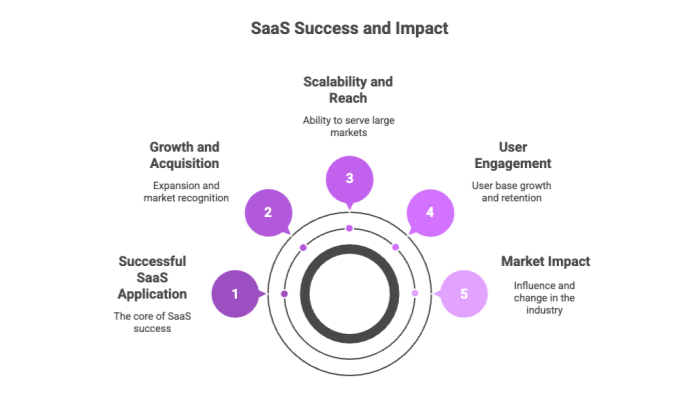

Summary
Summarizing the key points, SaaS application development involves multiple critical steps, from understanding the SaaS model and conducting market research to defining project scope, designing intuitive UI/UX, and selecting the right technology stack. Monetization models, testing, iteration, and scalability are also essential components of successful SaaS development.
Challenges such as data security, performance bottlenecks, and development costs need to be addressed thoughtfully. By selecting the right development team and learning from successful case studies, businesses can create SaaS products that meet user needs and thrive in the competitive market. The journey of SaaS development is complex but immensely rewarding, with the potential to revolutionize how businesses operate and interact with technology.

Frequently Asked Questions
In this section, we address common queries related to saas dev, covering essential topics such as cloud computing, data storage, and data processing.
We also discuss the importance of customer relationship management in SaaS apps, the role of experienced developers, and key considerations for managing a saas project. Whether you're exploring marketing strategies or internal tools for your saas business, these FAQs provide valuable insights to help you navigate the saas application development process effectively.
What are the key features of SaaS applications?
The key features of SaaS applications are centralized hosting, automatic updates, multi-tenant architecture, and accessibility from any device with an internet connection. These characteristics enhance user experience and streamline software management.
How do SaaS applications benefit businesses?
SaaS applications significantly benefit businesses by providing cost-effective subscription models, scalability, and automatic updates, which enhance flexibility and user experience. This ultimately leads to improved operational efficiency and accessibility.
What are the common challenges in SaaS development?
Common challenges in SaaS development include ensuring data security, managing performance bottlenecks, complying with regulations, and scaling the application effectively to meet user demands. Addressing these issues is critical for the success of a SaaS product.
How much does it cost to develop a SaaS application?
Developing a SaaS application typically costs between $30,000 and $80,000 for a basic MVP and can escalate to $150,000 to $500,000 for a full-scale product. It is also important to factor in ongoing maintenance and hosting expenses.
What should you consider when selecting a SaaS development team?
When selecting a SaaS development team, it is essential to ensure the team aligns with your business objectives, possesses skilled developers, and is cost-effective in managing specific tasks. Evaluating options such as in-house teams, outsourced teams, and freelancers will also be crucial in making the right choice.

